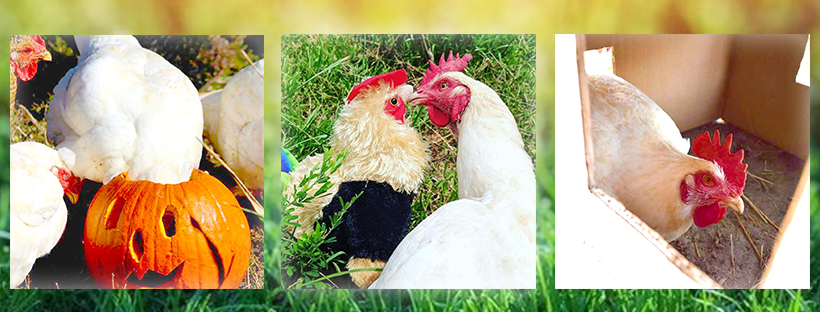Chicken Care 101: Social & Emotional Care

Thinking about adding chickens to your family? In this five-part blog series, we’ll cover the basics to help you decide if bringing chickens into your life is the right choice for both you and the birds. You’ll learn about chicken adoption, safe housing, medical care, proper diet, and the importance of social and emotional care.
In this post, you’ll learn about the importance of socializing with your chickens and how you can enrich their lives in a variety of ways. Please be sure to read article 1: Adopting Backyard Chickens, article 2: Housing, article 3: Happy, Healthy Chickens, and article 4: Nutritional Guidelines for Chickens before making any decisions about rescuing chickens.
Content is provided by Piedmont Farm Animal Refuge, a non-profit rescue and sanctuary for farm animals located in Pittsboro, North Carolina. Open for tours, volunteering, and more. Learn about the Refuge at www.piedmontrefuge.org and find more information at the bottom of this post.
Chickens Need Companionship
Chickens are extremely social and inquisitive animals. They love the company of one another and often form close bonds with other animals, including humans. Not only do chickens make good company, but they also have important social and emotional needs that, if not met, can cause loneliness, depression, or even contribute to physical illness. While society tends to teach us that chickens are “bird brains” with limited intellect, this could not be further from the truth. Spend some quality time with chickens and you will be impressed by their complex social structures and charmed by their unique personalities.
The Rule of Two
With chickens, as well as with most other animals, it’s best to abide by the rule of two. This means that you should strive to have at a minimum two animals of the same species living together. It’s crucial for most animals to live with others of their kind who have the ability to understand and speak the same language. Many species are naturally pack or herd animals who live in large social groups in the wild. This rule may not apply to all species or individual animals, especially depending on their background, so it’s always best to make decisions about this on a case-by-case basis.
Chickens typically enjoy flock mates immensely and can easily become depressed without other chickens around. When it comes to males and females, you will most likely need to have more than one hen for every rooster in your flock. Without the correct ratio, hens can be at risk of being over-mounted and getting injured. One rooster to every five hens is a good ratio to start with, adjusting the number of birds as needed.
Introducing Chickens to Each Other
If your adopted chickens did not come to you already in a bonded flock, you will need to ensure individual chickens are properly introduced to each other. Simply putting chickens in the same area without an introduction process can result in injury or in some cases death.
One excellent method of introduction is to place the new bird in a large wire dog crate (with their own set of food and water) within your chicken living area. When the flock is outdoors, move the crate to a shady spot outdoors. When the flock comes in for the night, move the crate into the house. Continue this process for a minimum of two days and up to one week. During this time, the birds will be able to interact through the crate without significantly injuring each other. The new bird will also be able to observe the established routine, which will help her integrate more quickly.
When you do let the birds have full contact with one another, be prepared for the possibility of a bit of pecking and ruffled neck feathers while they work out their hierarchy. Always be present and observe this initial contact to ensure things settle down and no one is getting bullied too much.
Age and Seasonal Changes
When roosters are young and go through their “teen years,” their hormones begin to kick in and they can sometimes become overly aggressive towards the hens. Many people mistakenly believe that roosters are going to be this way forever. However, in many cases roosters will calm down after six months to a year and will be just fine with the ladies for the rest of their days.
Seasons can also play a role in how chickens get along with one another. In particular, the breeding season can bring out hormones in both males and females. If you are noticing changes in how your birds are getting along, you may need to formulate a plan to temporarily separate them until the season passes. When bringing them back together again, be sure to follow the above-mentioned introduction procedure each time. Being away from their flock for even a few days can reset the social hierarchy and potentially cause some chaos.
Chickens and Other Animals
In addition to other chickens, your birds may get along with other animals. They may even become besties with another species! Many chickens can be friends with turkeys, ducks, cats, goats, or sheep. Dogs are sometimes gentle enough to be friends with chickens, but extreme caution should be taken to protect the safety of the birds. Dogs and chickens should never be left together unattended. Pigs and chickens can often get along, but ingested bacteria in pig poop can be deadly to chickens so it is best to keep them in separate areas. Similar to dogs, some pigs can also exhibit aggression towards chickens. Small rodents such as mice or gerbils, as well as some reptiles like lizards or frogs, may actually be viewed as a food source by your chickens(!), therefore it’s generally best to avoid having them interact. Again, individual personalities are going to vary quite a lot. The safety of all animals should always be the primary concern when considering an introduction.
How to Interact with Chickens
Communicating with chickens may take a little bit of practice, as well as some knowledge about chicken language. After all, they are birds and humans are mammals, so we may have to work a little harder to understand each other at first. One of the best ways to begin to form a relationship with your chickens is to spend some quality time with her. Since chickens are excellent at facial recognition, it’s a good idea to sit low to the ground so she can get to know your face, not your shoes. Taking time to sit with your chicken will help her warm up to you and will also give you time to observe her language and behaviors.
Did you know that chickens have at least 30 words and short phrases in their language? It’s easy to pick up on some of these words if you just take the time to observe. For example, if an insect or yummy treat is discovered, you may notice that a rooster (or even a hen) may start to “tidbit.” This is a vocalization in combination with a movement that serves to call over all the other chickens in the area so they can share in the feast. Other commonly heard words include the announcement of an egg that has just been laid and the warning call notifying the flock of a potential predator or threat.
When it comes to forming a close relationship with your chickens, you may notice that some are friendlier with you than others. Another member of your family may end up being closer to a different chicken than you are. It’s common for chickens to choose people to be their friends based on the individual personalities of both the chicken and the human.
Chickens often enjoy snuggling, getting stroked, and receiving light massages in certain areas of the body. You can (and should!) be affectionate towards them in the same way you might be with a dog or cat in your family (including cuddling, kissing, etc.). Here are some tips for how to share companionship and affection with chickens:
- Spend time socializing with your chickens often.
- Sit on the ground or on a mat so they can easily see your face.
- Offer treats out of your hand, such as raisins, from time to time.
- If your chickens seem relaxed in your presence, try picking one up and placing them in your lap. Many chickens love to snuggle!
- Chickens generally enjoy being stroked from head to tail, in line with the natural orientation of their feathers.
- Some places they like to get massaged include the wattles (skin flaps that hang below their face), the comb (red skin on top of the head), and the earlobes (circular skin on either side of their face below the ear hole).
Chicken Enrichment
Animal enrichment refers to activities or objects that help to stimulate the minds and senses of animals. Since domesticated animals are dependent on humans for most of their basic needs, life can be boring without something new and interesting to break up the day. Enrichment is also often provided to wild animals who must live in captivity due to injury or other reasons (such as at wildlife rehab centers or exotic animal rescues).
Enrichment is a very important part of animal care that is often overlooked. Chickens, being intelligent and inquisitive animals, can benefit from a wide variety of enrichment items. It can be a lot of fun to watch how chickens react to a new toy or enrichment puzzle.
Broad categories of enrichment include auditory (hearing), visual (seeing), olfactory (smelling), textural (feeling), and edible (tasting). Below are some ideas for chicken enrichment that have been successful at Piedmont Farm Animal Refuge. This list is just a starting point – get creative and see what you can come up with to entertain your birds! Making enrichment items can be a wonderful way for children to participate in caring for animals and can help to establish compassion and understanding towards animals at a young age. Safety should always be the first priority when it comes to providing enrichment, so always consider if the materials and food items are safe for your chickens.
Enrichment Ideas for Chickens
- Fresh fruits and vegetables: Make sure the items you are considering providing are safe and non-toxic for birds (refer to our previous article on chicken nutrition to help you with this). Fruits and vegetables can be enriching all on their own! Some favorites include watermelon and cooked pumpkin. You can also consider placing produce in a puzzle feeder or scattering it around their living areas in “scavenger hunt” style. Presenting produce in different forms can also be interesting for your birds. For example, blending up the items into a smoothie, freezing the items into a popsicle, or using a dehydrator to make fruit or veggie “chips” are all great ideas.
- Substrates: Chickens LOVE to dig through different materials on the ground. Mulch, sand, dirt, pine shavings, or even piles of leaves can generate a lot of interest. You could try to make a few small piles in their outdoor area and sit back and watch their reaction. You could also consider hiding snacks in the substrate for double the enrichment fun!
- Mirrors and stuffed animals: You might be amazed to witness the reaction of your chickens to seeing themselves reflected back in a mirror! Many birds talk to their reflection, show off to it, or even just seem to enjoy sitting with their newfound “friend.” Realistic stuffed chicken toys are easy to find online and can be super fun to watch them interact with, as well.
- Wooden ladders, platforms, or logs: Chickens are curious and love to investigate new items placed in their area. Build a little wooden platform or ladder for them to check out. Wood logs can be placed on the ground and rolled around from time to time. Chickens often enjoy sitting on top of the logs, and when you move them, it can expose tasty insects. A simple and cheap form of enrichment is reusing a large shipping box. Place the box upside down on the group and cut out doors and windows – just like human children your chickens may enjoy playing in a box fort!
- Music and sound effects: Buy a cheap boombox at the thrift store and find out what genre of music your chickens like best. In addition to classical, rock, metal, country, alternative, jazz, and other music styles, sound effect CDs can be fun to try out. Try out some animal sound effects and rainforest sounds (the native habitat of chickens)!
- Other food items: Besides produce, some other ideas for tasty treats include cooked eggs, seeds, grains, and nuts. Again, make sure the items you are giving out are non-toxic for chickens and are given in moderation. Recipes for fun chicken snacks, such as Chicken Trail Mix and Egg Salad, are included in our previous post, “Nutritional Guidelines for Chickens.”
Chickens are complex, intelligent, and wonderful beings. If you are lucky enough to have chickens in your life, we hope you will treat them with the love and respect that they deserve. Piedmont Farm Animal Refuge is a place where you can meet chickens and learn more about their amazing qualities. Attend a guided tour (offered weekly) or participate in our annual “Spring Chicken Day” event! You can learn more about how to get involved with our organization and submit your questions about chickens on our website at www.piedmontrefuge.org or contact us at info@piedmontrefuge.org.
Content provided by:
Lenore Braford
Founder & Shelter Manager
Piedmont Farm Animal Refuge
www.piedmontrefuge.org
www.facebook.com/PiedmontFarmAnimalRefuge
www.instagram.com/piedmont_farm_animal_refuge


